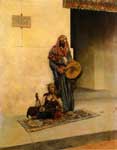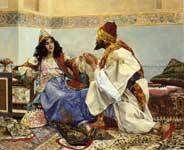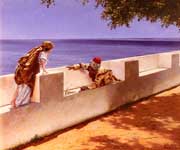Antonio Maria Fabrés y Costa
Paintings
Pope Benedict XV


Street Musicians in a Middle Eastern Town


Fine Art Prints | Greeting Cards | Phone Cases | Lifestyle | Face Masks | Men's , Women' Apparel | Home Decor | jigsaw puzzles | Notebooks | Tapestries | ...
Antonio Maria Fabrés y Costa (1854–1938), also known as Antonio Fabrés, was a famous Spanish artist during the turn of the 20th century. He was born in Barcelona Spain in 1854. It is said that he was the artist gene since his father was a draughtsman and his uncle a silversmith. He started studying at the Escuela de Bellas Artes in his native city at the age of 13. When he turned 21, he received a grant to study in Rome. There are records of his sculptures from early in his career but later on he became a painter almost exclusively. He joined Mariano Fortuny with a group that became known for their intense realism. Their popularity grew with the taste of the bourgeoisie seeking exotic images with oriental of medieval themes. He went back to Barcelona in 1886 and in 1894 he moved to Paris. The popularity he had earned during his decade in Italy helped him open a large studio where he could create complex scenes for the upper classes.
In 1902 the Academia de San Carlos decided to renovate their classical techniques with the ones of realism that were so popular in Europe at the time. Antonio Fabrés was called to take the place of Santiago Rebull as head of this important institution. Although some of his students went on to become what was later known as the Post-Revolutionary Movement in Mexican art, the faculty had a hard time adapting to his distinct style and personality. In 1907, he returned to Rome. One of his last commissions in Mexico was the decorations of a hall at the Porfirio Diaz mansion where he mainly focused on art nouveau style .
Fabrés was recognized most everywhere he traveled. He was acclaimed in Barcelona, London, Paris, Vienna and Lyon. At the end of his life he was dealt a very unfortunate blow when in 1926 he decided to donate a large amount of works to the Museo de Bellas Artes de Barcelona. In exchange for this generous donation he asked the Museum that a hall be built with his name, but the museum never built that hall and although he protested several times, they could never settle the argument. Antonio Fabrés died in Rome in 1938.
References
Artspawn. "Biography of Antonio Fabres", Biographical information about Antonio Fabres at Artspawn.
----
Fine Art Prints | Greeting Cards | Phone Cases | Lifestyle | Face Masks | Men's , Women' Apparel | Home Decor | jigsaw puzzles | Notebooks | Tapestries | ...
----
Artist
A - B - C - D - E - F - G - H - I - J - K - L - M -
N - O - P - Q - R - S - T - U - V - W - X - Y - Z
Retrieved from "http://en.wikipedia.org/"
All text is available under the terms of the GNU Free Documentation License





